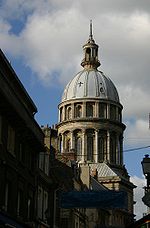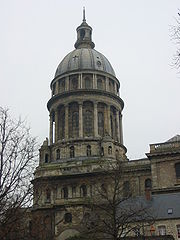
Notre-Dame de Boulogne
Encyclopedia

Minor basilica
Minor basilica is a title given to some Roman Catholic churches. By canon law no Catholic church can be honoured with the title of basilica unless by apostolic grant or from immemorial custom....
located in Boulogne-sur-Mer
Boulogne-sur-Mer
-Road:* Metropolitan bus services are operated by the TCRB* Coach services to Calais and Dunkerque* A16 motorway-Rail:* The main railway station is Gare de Boulogne-Ville and located in the south of the city....
in the Pas-de-Calais département of northern France
France
The French Republic , The French Republic , The French Republic , (commonly known as France , is a unitary semi-presidential republic in Western Europe with several overseas territories and islands located on other continents and in the Indian, Pacific, and Atlantic oceans. Metropolitan France...
. The basilica was built between 1827 and 1875 on the site of Boulogne's medieval cathedral with its 101 metre high dome. The basilica is still known locally as the "cathedral", despite the present church never having held that status.
History of the site
The site of modern Boulogne was occupied by the Romans and was used by the emperor ClaudiusClaudius
Claudius , was Roman Emperor from 41 to 54. A member of the Julio-Claudian dynasty, he was the son of Drusus and Antonia Minor. He was born at Lugdunum in Gaul and was the first Roman Emperor to be born outside Italy...
as his base for the Roman invasion of Britain
Roman Britain
Roman Britain was the part of the island of Great Britain controlled by the Roman Empire from AD 43 until ca. AD 410.The Romans referred to the imperial province as Britannia, which eventually comprised all of the island of Great Britain south of the fluid frontier with Caledonia...
. By the 4th century the town was a major port of the empire
Roman Empire
The Roman Empire was the post-Republican period of the ancient Roman civilization, characterised by an autocratic form of government and large territorial holdings in Europe and around the Mediterranean....
and known as Bononia.
The first Christian
Christianity
Christianity is a monotheistic religion based on the life and teachings of Jesus as presented in canonical gospels and other New Testament writings...
building on the site was probably built by the occupying Romans during the 4th-5th century, and would have occupied the peak of the hill that forms the modern 'haute ville'.
According to legend, in about 633, when Saint Audomare
Saint Audomare
Saint Audomar , better known as Saint Omer, was a Burgundy-born bishop of Thérouanne, after whom nearby Saint-Omer in northern France was named.-Biography:...
(Saint Omer) was a bishop, an unmanned boat carrying a luminous statue of the Virgin Mary was sighted in the estuary at Boulogne. The statue was carried to their church and soon miracles were reported at the site.
On the final Monday of August each day, a modern replica of the statue is paraded around the city, a tradition that has been held since 1854. The statue wears a soleil, a resplendent headdress that is worn by the townswomen during the parade.
Boulogne Cathedral
In around 1100 a new church was built on the site and over the next few centuries underwent numerous changes, such as the addition of a choir in the 14th century, and in 1567 Notre-Dame was made a cathedral. Between the 13th and 16th century the statue of "Our Lady of the Sea" became a popular site of pilgrimage, leading to a period of prosperity for the town.The cathedral flourished until the French Revolution
French Revolution
The French Revolution , sometimes distinguished as the 'Great French Revolution' , was a period of radical social and political upheaval in France and Europe. The absolute monarchy that had ruled France for centuries collapsed in three years...
when the 1790 Civil Constitution of the Clergy
Civil Constitution of the Clergy
The Civil Constitution of the Clergy was a law passed on 12 July 1790 during the French Revolution, that subordinated the Roman Catholic Church in France to the French government....
brought it under government control. Worship in the cathedral was prohibited at that time, with the city's convent of the Annonciades becoming the seat of worship, and after a period as a military warehouse the cathedral was sold to traders from outside Boulogne. The building was then demolished in stages and in 1793 its celebrated miraculous statue of "Our Lady of the Sea" was burned. Only a small portion of the statue's hand survived, still on display, and pilgrimages to visit the relic
Relic
In religion, a relic is a part of the body of a saint or a venerated person, or else another type of ancient religious object, carefully preserved for purposes of veneration or as a tangible memorial...
continued into the twentieth century. Of the original cathedral, only the impressive Romanesque
Romanesque architecture
Romanesque architecture is an architectural style of Medieval Europe characterised by semi-circular arches. There is no consensus for the beginning date of the Romanesque architecture, with proposals ranging from the 6th to the 10th century. It developed in the 12th century into the Gothic style,...
crypt of the medieval cathedral still exists.
In 1308 the church was the location of the wedding of Edward II of England
Edward II of England
Edward II , called Edward of Caernarfon, was King of England from 1307 until he was deposed by his wife Isabella in January 1327. He was the sixth Plantagenet king, in a line that began with the reign of Henry II...
to Isabella of France
Isabella of France
Isabella of France , sometimes described as the She-wolf of France, was Queen consort of England as the wife of Edward II of England. She was the youngest surviving child and only surviving daughter of Philip IV of France and Joan I of Navarre...
, an event commemorated by a memorial in the crypt.
Reconstruction
Following the destruction of the former cathedral, a local priest and self-taught architect, Benoit HaffreingueBenoit Haffreingue
Benoit Agathon Haffreingue was a French priest based in Boulogne-sur-Mer. He is known for having rebuilt the Cathedral of Notre Dame in Boulogne-sur-Mer as a result of what he believed was a call from God...
, vowed to rebuild the church to restore the honour of "Our Lady of the Sea" and return the episcopal seat to the city. After a strong campaign he was able to gain the support of many including Victor Hugo
Victor Hugo
Victor-Marie Hugo was a Frenchpoet, playwright, novelist, essayist, visual artist, statesman, human rights activist and exponent of the Romantic movement in France....
and François-René de Chateaubriand
François-René de Chateaubriand
François-René, vicomte de Chateaubriand was a French writer, politician, diplomat and historian. He is considered the founder of Romanticism in French literature.-Early life and exile:...
, and soon had considerable public opinion behind him.
Construction of his design began in 1827 with the building of the rotunda and continued for nearly fifty years. The dome that dominates the town was finished in 1854 and its western towers completed in the 1870s. However, despite the campaign the building never regained its episcopal seat, though in 1879 it was given the honorary title of a basilica.
The building

Classical architecture
Classical architecture is a mode of architecture employing vocabulary derived in part from the Greek and Roman architecture of classical antiquity, enriched by classicizing architectural practice in Europe since the Renaissance...
and renaissance
Renaissance
The Renaissance was a cultural movement that spanned roughly the 14th to the 17th century, beginning in Italy in the Late Middle Ages and later spreading to the rest of Europe. The term is also used more loosely to refer to the historical era, but since the changes of the Renaissance were not...
styles, and bears many similarities to St Paul's Cathedral
St Paul's Cathedral
St Paul's Cathedral, London, is a Church of England cathedral and seat of the Bishop of London. Its dedication to Paul the Apostle dates back to the original church on this site, founded in AD 604. St Paul's sits at the top of Ludgate Hill, the highest point in the City of London, and is the mother...
. The area beneath the dome was initially designed to form the complete church, but additional funding allowed the expansion to the nave and transept that form a Latin cross. This gives the finished building the unusual internal appearance of being formed by two distinct churches.
The tall nave is dominated by its rows of slender Corinthian columns, with unusual features scattered throughout. Haffreingue's lack of professional training unfortunately gave the building an inherent fragility that led to the collapse of the nave's arches in 1921. During their reconstruction the whole building was reinforced with concrete, which without doubt allowed it to survive the bombing received by the city during the Second World War.
The crypt
When Haffreingue began work on the new church in 1827, the workmen discovered a crypt that had lain unknown for centuries, having probably been filled in during the 1544 siege of Boulogne by Henry VIII of EnglandHenry VIII of England
Henry VIII was King of England from 21 April 1509 until his death. He was Lord, and later King, of Ireland, as well as continuing the nominal claim by the English monarchs to the Kingdom of France...
. The crypt is 128 metres long in total, and is believed to be the longest in France. Its Romanesque columns date back to the 11th century
With 19th century masonry lying alongside the original medieval work, the many rooms also include the foundations of a Roman temple dedicated to Mars. Cannon balls from the 1544 siege lie alongside offerings from the site's many medieval pilgrims.
The crypt includes a chapel in which the body of José de San Martín
José de San Martín
José Francisco de San Martín, known simply as Don José de San Martín , was an Argentine general and the prime leader of the southern part of South America's successful struggle for independence from Spain.Born in Yapeyú, Corrientes , he left his mother country at the...
, the South American liberator, was buried between his death in 1850 and its return to Buenos Aires
Buenos Aires
Buenos Aires is the capital and largest city of Argentina, and the second-largest metropolitan area in South America, after São Paulo. It is located on the western shore of the estuary of the Río de la Plata, on the southeastern coast of the South American continent...
in 1861.

